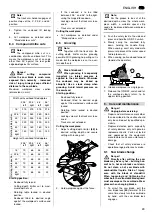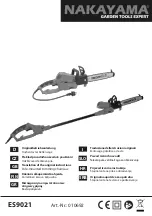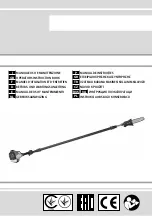
18
ENGLISH
objects such as radiators, pipes,
cooking stoves, refrigerators when
operating this tool.
•
Do not use the power cable for pur-
poses it is not intended for.
A
Risk of injury by moving parts!
•
Do not operate the tool without
installed guards.
•
Always keep sufficient distance to
the saw blade. Use suitable feeding
aids, if necessary. Keep sufficient
distance to driven components
when operating the tool.
•
Wait for the saw blade to come to a
complete stop before removing cut-
offs, scrap, etc. from the work area.
•
Cut only stock of dimensions that
allow for safe and secure holding
while cutting.
•
Do not attempt to stop the saw
blade by pushing the workpiece
against its side.
•
Ensure the tool is disconnected from
power before servicing.
•
Ensure that when switching on (e.g.
after servicing) no tools or loose
parts are left on or in the tool.
•
Unplug if the tool is not used.
A
Cutting hazard, even with the
cutting tool at standstill!
•
Wear gloves when changing cutting
tools.
•
Store saw blade in such manner that
nobody will get hurt.
A
Risk of sawhead kickback (the
saw blade is caught in the workpiece
and the sawhead kicked up all of a
sudden)!
•
Make sure the saw blade is suitable
for the workpiece material.
•
Hold the handle firmly. When the
saw blade enters the workpiece, the
kickback risk is particularly high.
•
Cut thin or thin-walled workpieces
only with fine-toothed saw blades.
•
Always use sharp saw blades.
Replace blunt saw blades at once.
Increased risk of kickback when a
blunt tooth gets caught by the work-
piece's surface.
•
Do not jam workpieces.
•
Avoid lateral pressure on the saw
blade when grooving – use a stock
clamp.
•
If in doubt, check workpiece for
inclusion of foreign matter (e.g. nails
or screws).
•
Never cut several workpieces at the
same time – and also no bundles
containing several individual pieces.
Risk of personal injury if individual
pieces are caught by the saw blade
uncontrolled.
c
Drawing-in/trapping hazard!
•
Ensure that no parts of the body or
clothing can be caught and drawn in
by rotating components (
no
neck-
ties,
no
gloves, no loose-fitting
clothes; contain long hair with hair-
net).
•
Never attempt to cut any workpieces
which contain
−
ropes,
−
strings,
−
cords,
−
cables or
−
wires, or to which any of the
above are attached.
A
Hazard generated by insuffi-
cient personal protection gear!
•
Wear hearing protection.
•
Wear safety glasses.
•
Wear dust mask.
•
Wear suitable work clothes.
•
Wear non-slip shoes.
A
Risk of injury by inhaled wood
dust!
•
Dust of certain timber species (e.g.
beech, oak, ash) can cause cancer
when inhaled. Work only with a suit-
able dust collector attached to the
saw. The dust collector must comply
with the data stated in the technical
specifications.
•
Ensure that as little as possible
wood dust will get into the environ-
ment:
−
remove wood dust deposit in the
work area (do not blow away!);
−
fix any leakages on the dust col-
lector;
−
ensure good ventilation.
A
Hazard generated by modifica-
tion of the machine or use of parts
not tested and approved by the equip-
ment manufacturer!
•
Assemble tool in strict accordance
with these instructions.
•
Use only parts approved by the
equipment manufacturer. This
applies especially for:
−
saw blades (see "Technical spec-
ifications" for stock nos.);
−
safety devices (see "Technical
specifications" for stock nos.).
•
Do not change any parts.
A
Hazard generated by tool
defects!
•
Keep tool and accessories in good
repair. Observe the maintenance
instructions.
•
Before any use check tool for possi-
ble damage: before operating the
tool all safety devices, protective
guards or slightly damaged parts
need to be checked for proper func-
tion as specified. Check to see that
all moving parts work properly and
do not jam. All parts must be cor-
rectly installed and meet all condi-
tions necessary for the proper oper-
ation of the tool.
•
Do not use damaged or warped saw
blades.
•
Damaged protection devices or
parts must be repaired or replaced
by a qualified specialist. Have dam-
aged switches replaced by a service
centre. Do not operate tool if the
switch can not be turned ON or
OFF.
•
Keep handles free of oil and grease.
A
Risk of injury by noise!
•
Wear hearing protection.
•
For reasons of noise protection do
not use warped saw blades. A
warped blade is exiting vibrations to
an especially large extent, which
means noise.
3.3
Symbols on the machine
A
Danger!
Disregard of the following
warnings can lead to severe personal
injury or material damage.
Read instructions.
Do not reach into the run-
ning saw blade.
Wear safety goggles and
hearing protection.
Do not operate tool in moist
or wet environment.
Do not carry tool at
the handle; the han-
dle is not designed to
bear the weight of the
tool.

































